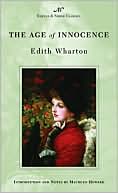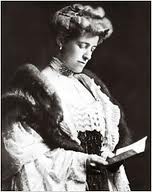Newland Archer: “a man to whom nothing was ever to happen.”
Newland Archer, th e protagonist of this ironically entitled novel set in the late nineteenth century, is a proper New York gentleman, and part of a society which adheres to strict social codes, subordinating all aspects of life to doing what is expected, which is synonymous with doing what it right. As the author remarks early in the novel, “Few things were more awful than an offense against Taste.” Newland meets and marries May Welland, an unimaginative, shallow young woman whose upbringing has made her the perfect, inoffensive wife, one who knows how to behave and how to adhere to the “rules” of the society in which they live.
e protagonist of this ironically entitled novel set in the late nineteenth century, is a proper New York gentleman, and part of a society which adheres to strict social codes, subordinating all aspects of life to doing what is expected, which is synonymous with doing what it right. As the author remarks early in the novel, “Few things were more awful than an offense against Taste.” Newland meets and marries May Welland, an unimaginative, shallow young woman whose upbringing has made her the perfect, inoffensive wife, one who knows how to behave and how to adhere to the “rules” of the society in which they live.
When Newland is reintroduced to May’s cousin, Countess Ellen Olenska, who has left her husband in Europe and now wants a divorce, he finds himself utterly captivated by her freedom and her willingness to risk all, socially, by flouting convention. Both Ellen and Newland, however, are products of their upbringing and their culture, and they dutifully resist their feelings because of their separate social obligations. Various meetings between them suggest that their feelings are far stronger than what is obvious on the surface, and the question of whether either of them will finally state their feelings pervades the novel.
Author Edith Wharton creates an exceptionally realistic picture of New York in the post-Civil War era, a time in which aristocrats of inherited wealth found themselves competing socially with parvenus, and social rules were changing. Her ability to show the conflict between a person’s desire for freedom and his/her need for social acceptance is striking. As the various characters make their peace with their decisions–either to conform to or to challenge social dictates–the novel achieves an unusual dramatic tension, subtle because of its lack of direct confrontation and powerful in its effects on individual destinies. This is, in fact, less an “age of innocence” than it is an age of social manipulation.
Wharton herself manipulates the reader–her best dialogues are those in which the characters never actually participate–conversations that they keep to themselves, confrontations which they never allow themselves to have, and resolutions which happen through inaction rather than through decision-making. Filled with acute social observations, the novel shows individuals convincing themselves that obeying social dictates is the right thing to do. Though the novel sometimes seems to smother the reader with its limitations on action, Age of Innocence brilliantly captures the age and attitudes of the era
Notes: The author’s photo is from
http://topics.nytimes.com/topics/reference/timestopics
Also reviewed here: SUMMER, THE HOUSE OF MIRTH, GLIMPSES OF THE MOON

